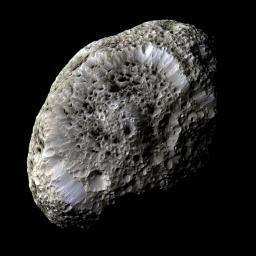This stunning false-color view of Saturn's moon Hyperion reveals crisp
details across the strange, tumbling moon's surface. Differences in color
could represent differences in the composition of surface materials. The
view was obtained during Cassini's close flyby on Sept. 26, 2005.
Hyperion has a notably reddish tint when viewed in natural color. The red
color was toned down in this false-color view, and the other hues were
enhanced, in order to make more subtle color variations across Hyperion's
surface more apparent.
Cassini scientists think that Hyperion’s unusual appearance can be attributed
to the fact that it has an unusually low density for such a large object, giving
it weak surface gravity and high porosity. These characteristics help preserve
the original shapes of Hyperion’s craters by limiting the amount of impact ejecta
coating the moon’s surface. Impactors tend to make craters by compressing
the surface material, rather than blasting it out. Further, Hyperion’s weak gravity,
and correspondingly low escape velocity, means that what little ejecta is
produced has a good chance of escaping the moon altogether.
Images taken using infrared, green and ultraviolet spectral filters were
combined to create this view. The images were taken with the Cassini
spacecraft's narrow-angle camera at a distance of approximately 62,000
kilometers (38,500 miles) from Hyperion and at a Sun-Hyperion-spacecraft,
or phase, angle of 52 degrees. The image scale is 362 meters (1,200 feet)
per pixel.
The Cassini-Huygens mission is a cooperative project of NASA, the
European Space Agency and the Italian Space Agency. The Jet Propulsion
Laboratory, a division of the California Institute of Technology in
Pasadena, manages the mission for NASA's Science Mission Directorate,
Washington, D.C. The Cassini orbiter and its two onboard cameras were
designed, developed and assembled at JPL. The imaging operations center
is based at the Space Science Institute in Boulder, Colo.
For more information about the Cassini-Huygens mission visit http://saturn.jpl.nasa.gov.
For additional images visit the Cassini imaging team homepage http://ciclops.org.

 Planetary Data System
Planetary Data System












